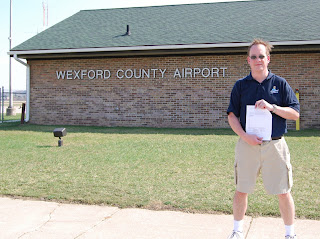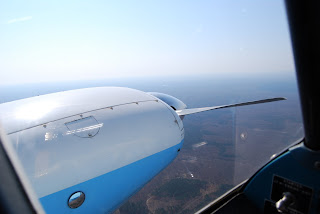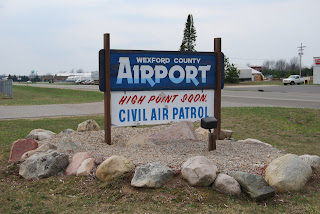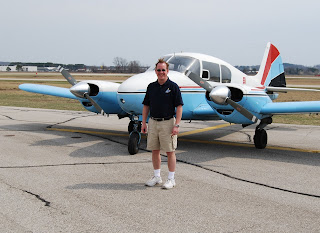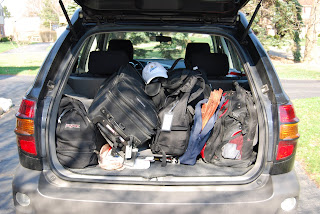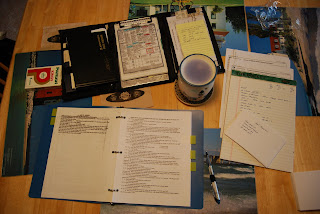Subscribe to Airspeed through iTunes or your favorite other podcatcher. Or listen online right here by clicking: http://media.libsyn.com/media/airspeed/AirspeedMultiDay2.mp3. It’s all free!
The feeling is starting to come back in my right leg and I can almost open and close my left hand again.
But it’s all worthwhile because I just added Airplane Multiengine Land to my ticket! And it doesn’t have the VFR restriction. Too cool!
I just finished the two-day accelerated multi-engine course with Tom Brady of Traverse Air. We flew at Wexford County Airport in Cadillac (KCAD) Saturday and Sunday. Two flights of 2.0 each and four instrument approaches and nine landings Saturday. Sunday was two shorter flights of 1.5 hours each and four instrument approaches and seven landings. Then the checkride Sunday afternoon with 1.2 (pilot in command!) hours, one instrument approach, and two landings.
I also got my complex endorsement as part of the process.
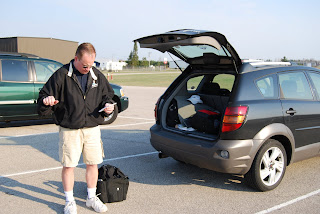 Lots of studying for this. A lot to get into your head in just two days. Here’s the obligatory parking-lot engine failure drill. I think I had just stomped on the ball and was going to full forward on the levers here.
Lots of studying for this. A lot to get into your head in just two days. Here’s the obligatory parking-lot engine failure drill. I think I had just stomped on the ball and was going to full forward on the levers here.
That would be the left engine and prop and, yes, that would be the prop feathered and not turning. We did two or three full-feathered shutdowns throughout the training and the checkride. This is the second one – on the last flight with Tom. Pretty benign, actually. It’s really amazing how much drag you get with a windmilling prop that’s full forward. Other than a fair amount of rudder and some bank into the good engine, it’s pretty much like flying with both engines at lower power once you get the dead engine shut down and feathered.
 Capt. Force at the controls. This was on the way out to the practice area after an engine failure on the runway and another right after takeoff. Note the maneuver cheat sheet stuck in the headliner, ready for reference. Whereas I simply memorized the setup for other checkrides, there’s just too much information and too short a time to internalize all of the maneuver setups. Memorize the stuff that is truly memory stuff (e.g. push up, clean up, gas, pumps, verify, feather) and use checklists for the other stuff. I made a lot of outlines in law school, but the primary benefit of the outlines were actually making the outlines. It usually took only a couple of glances at the cheat sheet in the course of setting up for a given maneuver, but it was very helpful knowing that it was there.
Capt. Force at the controls. This was on the way out to the practice area after an engine failure on the runway and another right after takeoff. Note the maneuver cheat sheet stuck in the headliner, ready for reference. Whereas I simply memorized the setup for other checkrides, there’s just too much information and too short a time to internalize all of the maneuver setups. Memorize the stuff that is truly memory stuff (e.g. push up, clean up, gas, pumps, verify, feather) and use checklists for the other stuff. I made a lot of outlines in law school, but the primary benefit of the outlines were actually making the outlines. It usually took only a couple of glances at the cheat sheet in the course of setting up for a given maneuver, but it was very helpful knowing that it was there.
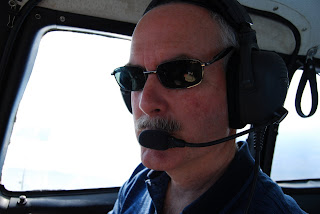 Multi instructor extraordinaire Tom Brady in the right seat. Tom made the whole thing systematic and as easy to digest as possible. I’m not saying that it was easy. It wasn’t. But Tom did a great job of presenting the material in a cogent way that could be rapidly absorbed by a competent pilot who arrived prepared.
Multi instructor extraordinaire Tom Brady in the right seat. Tom made the whole thing systematic and as easy to digest as possible. I’m not saying that it was easy. It wasn’t. But Tom did a great job of presenting the material in a cogent way that could be rapidly absorbed by a competent pilot who arrived prepared.
It’s an accelerated course. In Tom’s or any other accelerated course, you’re going to have to show up having read all of the materials and having a good understanding of the theory before you get in the car to go to the airport. You should be current and proficient in single-engine aircraft and it would be a great idea to have some complex time, too. (I got my only complex time just a few days before the multi training, but even that little bit really helped.)
You’ll have to have all of your stick and rudder skills second nature because you will spend the entire weekend working on the multi-specific stuff. You must have your A-game together so that you can pay attention to the multi-specific information. There’s only enough time (and you probably only have enough energy) to learn the multi stuff. If you’re not used to holding an airspeed within five KIAS, holding an altitude within 50 feet, and otherwise doing what you need to do in a single, all of those basic things will take up bandwidth that you need for the multi. You don’t have time or energy enough to take the rust off of your single-engine flying skills while picking up the multi skills. I’m usually pretty good with airspeed, altitude, and other precision matters. But I was consistently 100-200 feet high and a little fast in the Apache until late the second day. I don’t want to think about what this weekend would have been like if I hadn’t gotten up in the Cutlass a few days before.
Lastly (at least until I get an episode out covering the whole training experience), is it just me or does everyone draw great designated examiners? Kevin Spaulding gave me a great checkride. He started with a measured and thoughtful discussion of what we were going to do and used that discussion as an outline to talk through the required information. Weight and balance, performance, the elements of Vmc, how those elements affected maneuverability, etc. Then he was relaxed and objective during the checkride.
I floated the cabin once on the instrument approach. I think I pushed at the same time there was a downdraft, but if there really wasn’t a downdraft, I’ll take the responsibility. But that was a huge float.
Unlike many of the training approaches, I nailed the heading the whole way down the stairs. I got a little busy playing with the power and that might have contributed to some of the pitch oscillations. As soon as I relaxed a little on the corrections, things got a lot smoother. Funny how that works . . .
If you’re near Traverse City or Cadillac, Michigan (or if your family can find ways in those places to amuse themselves while you’re flying your ass off for a couple of days), consider the accelerated multi-engine program at Traverse Air with Tom Brady.
Traverse Air, Inc.
294 West Silver Lake
Traverse City, Michigan 49686
231-943-4128
tbrady294@charter.net
http://www.traverseair.com/
Tom also does seaplane ratings in a PA-12! Hmmmm. I think we’re going to Traverse City for vacation this summer . . .
